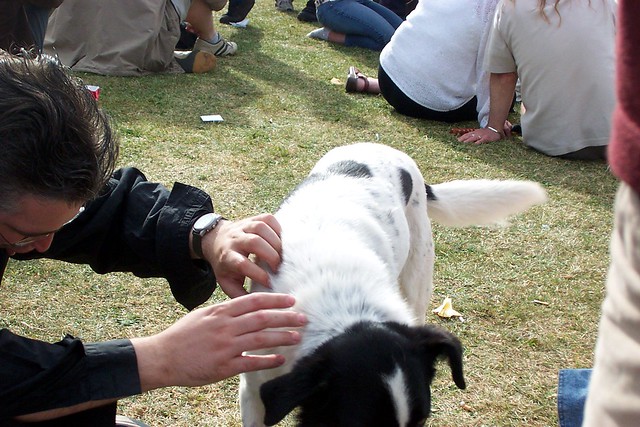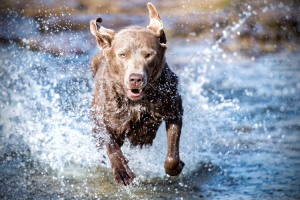What is every pet owner’s worst nightmare?
Why do perfectly happy pups suddenly start biting and chewing their own skin?
How does a beautiful golden retriever go from blonde to bald?
If you are a dog owner, then we are sure you know what we are getting at. Dark brown, copper-ish little menaces called FLEAS!
It is remarkable how these tiny little creatures can cause so much damage. They can make your dogs go crazy from itching and rashes. They can spoil your beautiful dog’s fur that you have worked so hard to groom. But most importantly, they can make you and your pets sick.
This post contains everything about dog fleas and how you can easily spot those nasty creatures, as well as, prevention from future flea infestations. You’ll also find some most efficient tools to get rid of fleas from your dogs and/or home. So, let’s start with their intro.
Related: Does Coconut Oil Kill Fleas?
Table of Contents
What are Dog Fleas?
Fleas are like tiny blood-sucking vampires that feed off your poor pups. They are parasites or insects that are about 1 to 2 mm long, just visible to the naked eye (but mostly hidden under the fur). The most common of these is Ctenocephalides canis, more popularly known by its less scary name, dog flea.
Although these insects have no wings, they do have compact bodies with long back legs, which makes it easy for them to jump from host to host such as pup to pup, a pup to other pets, other pets to pups, and pup to you
While most dog fleas can only live up to two weeks, the female uses this time to lay as many as 40 eggs a day. In fact, these eggs might be hiding in your homes, under your carpets and beds as you read this. Don’t be alarmed, we are only kidding, or are we?
But seriously, flea eggs can be lying around peacefully for days. They are not a problem until they are exposed to heat and warmth, which explains why dog fleas are more common during the summer months or more severe in hot and humid areas.
The flea eggs first transform onto larvae and then into something called a pupa before finally, an adult flea emerges. The cycle is important to know about because it helps you understand how severe your flea problem is and how you should be treating it.
How to know if your dogs have fleas?
How to know for sure if your dog has fleas? Well, the poor guy will be scratching himself crazy, which we are sure will be hard to miss. But then dogs can scratch and itch because of other causes besides fleas. So, how does one know for sure?
Well, don’t worry because we have got all sorted for you right here. Flea infestations in dogs start off by the occasional scratching here and there.
You gradually start to see more dog hair around the house than usual. Meanwhile, your pup’s fur will start to show visible thining.
As time goes on you will notice a pattern, your dog will frequently
- Scratch
- Bite his own fur off
- Show signs of skin inflammation
- Develop pale gums
- Have red patches
- Have tiny black and brown specks crawling on their skin
However, if you are still unsure about your potential flea situation, you can go one step ahead and confirm your suspicions by physical exam and it’s easy peasy.
Just lay down your doggies on their side and check areas with thin hair for tiny black/ brown crawling insects.
You can also get a flea comb from your local pet store and run it through your pup’s hair. If you comb your dog with enough pressure, you might be able to get a few of the fleas off your dog’s fur. (But beware, fleas are surprisingly fast, and they tend to hop away as soon they are separated from their host)
How do I know if Fleas are Hidden in my home?
Dog fleas are quite messy; they leave traces of evidence behind everywhere. If you have got dog fleas hiding in your homes, you will notice reddish-brown specks around the house.
These specks are the digested blood that fleas excrete or poop out. We call them flea dirt because anything else sounds too disgusting to talk about.
One thing that makes flea dirt look different from the regular dirt around your house is that when sprayed with water, flea dirt turns a darker shade of red.
Related: Best Shampoos for Bernedoodles
Why do dogs get fleas?
Dogs are beautiful creatures, full of love and happiness. What did they ever do to deserve fleas?
Well, to put it plainly, the fur of your dog is to a flea what the Bahamas are to humans—the perfect destination to live out one’s life.
We are not kidding, dog fur, thanks to its soft and warm nature, makes the perfect habitat for fleas.
Like all pets, dogs love playing outdoors and bringing all sorts of trash into the house. In that same way, dogs often bring fleas from the environment or other animals inside the house.
Why are Dog Fleas bad?
In case you don’t already know, let us clear it out for you, dog fleas are bad, really really bad.
Don’t be fooled by their small sizes, dog fleas are very dangerous and not just for your pets but you as well.
If it isn’t enough that fleas can make your dog go bald with itching and cause red bumps on its skin, here’s more.
Fleas are greedy blood-sucking monsters, and no, we are not exaggerating. Did you know that female dog flea can drink up to 15 times its weight in blood?
Now, imagine dozens of fleas feeding off your poor little pup. See the problem yet?
Flea infestations in dogs can lead to anemia in dogs. The excessive blood loss in pups causes their gums to turn pale and leaves them frail and weak.
What is even worse is that these fleas tend to carry a multitude of diseases. They transfer these diseases from other creatures to your dogs when they bite them.
Did you know that fleas can cause tapeworms, Bartonella, and in rare cases, even the bubonic plague?
So yes, fleas are pretty dangerous, and they don’t spare humans.
Why Are Fleas Dangerous for Humans?
Once your pup gets fleas, it is only a matter of time before you get them too.
Like we mentioned above, fleas like blood, dog blood, human blood, or any other living being’s blood are all the same to them.
Fortunately, they don’t like humans all that match and will go back to living on the dog after a few tasty bites. But those bites are enough to do some serious harm. The bites are itchy and tend to cause bumps on the skin.
Help, My dog has fleas!

If you are still reading, then it is the same to assume that you and your doggo have a bit of flea situation. But don’t worry, we are here to help.
Fleas may be annoying and stubborn, but no one messes with our dogs and gets away with it.
Getting rid of dog fleas is a multi-stage process, so listen carefully
Step 1- Secure the dog
The first step is to treat your dog with a combination of veterinary and non-veterinary products. Go to your vet or local pet store and grab the following items or order them online via Amazon.
- Specially formulated flea shampoos – that helps kill and wash off adult fleas. Then you can clean off the dog’s fur using a flea comb dipped in soap water.
- Flea sprays – It absorbs into the dog’s body and kills fleas when they try to bite your pet.
- Oral medication – Usually, one dose is enough to kill adult fleas on the dog
- Injections – when given to the dog it stops the fleas living on it from reproducing.
Other products like non-veterinary items may also be useful at this stage. Just prepare a spray bottle with rosemary or eucalyptus solution and add a few drops of essential oils. These are known to repel fleas, and regular sprays will stop fleas from returning to your dog’s body.
Once you have started treating your dog, it is time to move on to the rest of your house.
Step 2- Clean the house
Fleas are sneaky. They hide in your carpets, bedding, mats, and wait to jump onto your dogs.
Once you have started treating your dogs, it is time to clean your house. So you can pull out fleas from every corner and stop them from reinfecting your dogs.
Use flea spray on your carpets, mats, and beddings, and vacuum everything to pull off flea eggs. Next, pop it all in your washing machine and clean everything with detergent. Repeat the process for at least three months and even longer if the fleas don’t disappear.
Wipe all household furniture with a disinfectant leaving no place to hide for those fleas.
While this, usually does the trick and house fleas soon start to disappear. In some cases, the infestation is so bad that it may require professional pest control.
Now, we move on to the third phase, prevention.
Step 3- Prevent dog fleas from returning
Removing dog fleas is not enough; you have to make sure those little monsters never come back. So, once you and your pup are done celebrating, it is time to get back to work.
To ensure dog fleas stay away in the future, get your dog a flea collar. Now, flea collars are not super effective, but they certainly help. They have a limited range and treat only the neck area, but something is better than nothing.
You should also apply spot-on to your dog’s body. This is a liquid solution that prevents flea eggs from developing on your dog’s fur.
Another preventative measure is to comb your pet’s hair for examination regularly. So if there’s a flea invasion happening on your pup’s body, you are there to stop it.
We would also advise you to feed your doggo with healthy raw protein, so your fur baby is strong enough to withstand fleas.
But it does not stop here, and you will also have to frequently vacuum, clean, and replace carpets and bedding around your house. This way, fleas, and their eggs won’t be able to hide in your homes.
You can even go one step ahead and spray insecticides and pesticides in your yards. This will keep fleas away from your immediate outdoors so your pet can play freely.
You may like reading How to Teach Your Kids the Responsibilities of Pet Care
Some Best Ways to Fight Dog Fleas:
There are several tools and medicines available to treat fleas in dogs. Given below are some of the best ways to prevent fleas in dogs or to get rid of them if they have already got them.
Dog Flea Collars
Dog Flea Collars contain tick and flea repellant chemicals that provide protection to your pet by continuously releasing from the collar and spreading throughout your dog’s coat. But remember, there are specifications, not all dogs can wear the same type of flea collar. Also, newborn puppies, senior dogs, and pregnant and nursing bitches should not wear a tick and flea collar until your vet allow you to do so.
Flea Drops
Flea drops are said to be one of the effective methods to kill fleas, ticks, lice, and mosquitoes. They are directly applied to your dog’s skin and quickly spread across the skin. There are several types of flea drops, some are effective in controlling the fleas and ticks while many have the ability to control the growth of eggs.
There may be different types of flea drops for different species of pets so the best practice is to consult your vet before choosing the right one.
Flea Powders
As the name indicates, it is a powder that can be applied directly to your pets and the surrounding environment to kill fleas and lice. It is usually sprinkled on your pet’s coat and brushed against the fur. If you are in the area where fleas are in abundance, it can be used weekly or whenever you find a flea on your pets, you can use it.
Flea Combs
A Flea Comb is an effective handheld tool to help you remove fleas from your dog’s fur without using any toxins. By using a flea comb on your dog, you can get rid of fleas, flea eggs, and flea dirt. A flea comb should be used in a bathtub or outside to make sure none of the fleas or flea eggs remain there in your house.
Flea Shampoos
Flea Shampoos are used to get rid of fleas while bathing your dogs. It is a less effective method and usually used in combination with some other products. If your dog has a severe flea problem, you should not use flea shampoos, instead, you are recommended to see your vet asap.
Oral Medicine
Yes, there are several oral medications to get rid of fleas and ticks that come in the form of pills or chewable. There are different types of oral medicines for dog fleas and you should get an opinion from your vet on which one to give to your dog.
Wrapping it up:
Dogs’ fleas are scary, annoying, and very hard to get rid of. But owning a doggo isn’t all sunshine and happiness. It is hard and consistent work. It is a huge responsibility to have another being rely on you so profoundly. So, you should take extra good care of your pups.
Make sure they are properly vaccinated, not infected by fleas and if they are, come back to this article, so you know exactly what to do. Fleas may be hard to win from at first, but with persistent effort, you can get rid of them.
So, that is It, folks. We hope you had an informational time reading this. Lots of love to you and your pups!
Recommended read:
First Aid Kit for Pets
Goldendoodle puppy starter kit
Bernedoodle puppy starter kit










